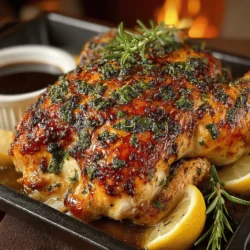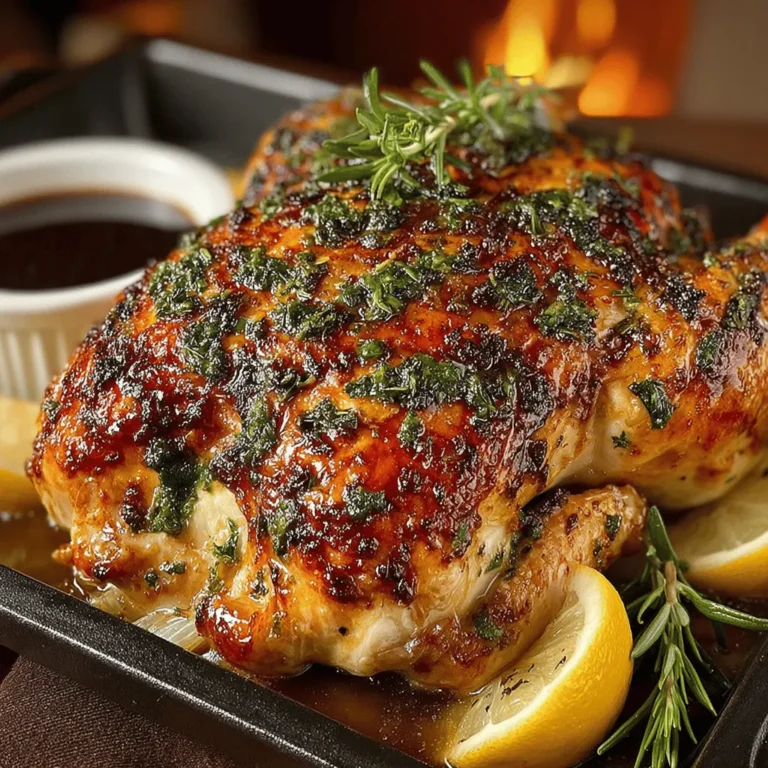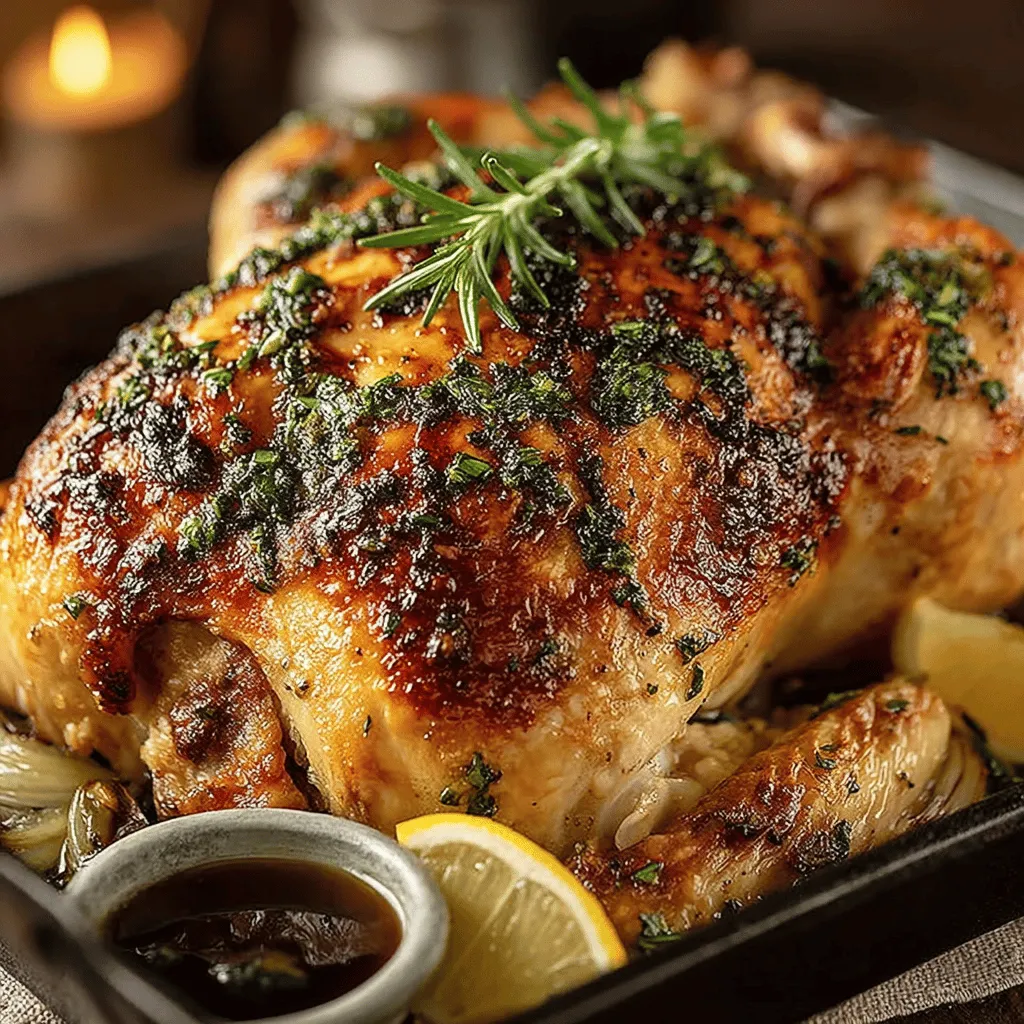Thanksgiving Bliss Turkey Delight: A Savory Tradition for Your Holiday Table
Introduction
Thanksgiving is a cherished holiday where family and friends gather to express gratitude and enjoy a sumptuous feast. At the heart of this celebration is the turkey, often referred to as the centerpiece of the Thanksgiving table. The “Thanksgiving Bliss Turkey Delight” recipe elevates this traditional dish, combining classic flavors with a touch of elegance. This article will guide you through each step of preparing a perfectly roasted turkey, ensuring your holiday meal is both memorable and delicious.
As the aroma of a perfectly roasted turkey fills the air, it sets the tone for the gathering. This recipe not only celebrates the essence of Thanksgiving but also incorporates a blend of herbs, spices, and cooking techniques that promise to delight your guests. The Thanksgiving Bliss Turkey Delight is more than just a meal; it represents a tradition, a culmination of family recipes passed down through generations, and a chance to create new memories around the table.
Understanding Your Turkey: Choosing the Right Bird
Before diving into the preparation of your Thanksgiving Bliss Turkey Delight, it’s essential to understand how to choose the right turkey for your feast. The selection of your bird can significantly impact the outcome of your dish, affecting both flavor and presentation.
Selecting the Perfect Size Turkey
When choosing a turkey, size matters. A general rule of thumb is to allocate 1 to 1.5 pounds of turkey per person. This ensures that everyone will have enough to enjoy during the meal and possibly some leftovers for post-Thanksgiving sandwiches. For small gatherings, a turkey weighing around 10 to 12 pounds is usually sufficient, whereas larger families may require a bird that weighs 18 pounds or more. Remember that turkeys can vary significantly in size, so planning ahead will help ensure you have the perfect bird for your table.
Fresh vs. Frozen: What You Need to Know
Another important consideration is whether to go for a fresh or frozen turkey. Fresh turkeys are typically more flavorful and juicier, but they require more careful handling and should be purchased closer to the holiday. On the other hand, frozen turkeys are often more convenient and can be bought well in advance. If you choose a frozen turkey, make sure to allow ample time for thawing, which can take several days in the refrigerator depending on the size of the bird.
Importance of Thawing: Safe Practices
If you’ve opted for a frozen turkey, proper thawing is critical to ensure food safety and quality. The best and safest method is to thaw the turkey in the refrigerator, allowing 24 hours for every 4-5 pounds. For example, a 16-pound turkey will require approximately 4 days to thaw completely. If you’re short on time, a cold water thawing method can be used, where the turkey is submerged in its original packaging in cold water, changing the water every 30 minutes. This method takes about 30 minutes per pound, but it requires more attention and care.
Preparing the Turkey: Step-by-Step Guide
Once you’ve selected and thawed your turkey, it’s time to prepare it for roasting. Proper preparation is essential for achieving that golden-brown skin and juicy meat that everyone looks forward to during Thanksgiving.
Setting the Stage: Prepping Your Kitchen
Before you start, it’s vital to prep your kitchen. Ensure you have all your ingredients and tools at hand, including a roasting pan, a meat thermometer, and a carving knife. Clean your workspace thoroughly and collect any herbs, spices, and seasonings you plan to use. Having everything ready will streamline the process and reduce the likelihood of forgetting essential steps.
Removing Giblets and Patting Dry: Key Preparation Steps
Next, it’s time to prepare the turkey itself. Most turkeys come with a bag of giblets (the neck, heart, liver, and gizzard) tucked inside the cavity. These can be removed and set aside for making gravy or broth later. Once the giblets are out, make sure to rinse the turkey under cold water and pat it dry with paper towels. Drying the skin is crucial, as it helps achieve that irresistible crispy skin when roasting.
Room Temperature: Why It Matters Before Cooking
Before cooking, allow the turkey to sit at room temperature for about 30 minutes. This step is essential because it ensures more even cooking throughout the bird. If the turkey is too cold when it goes into the oven, the outer parts may cook faster than the inner sections, leading to an unevenly cooked bird. A room-temperature turkey will roast more evenly, delivering a perfectly juicy result.
Crafting the Herb Butter: The Secret to Flavor
One of the key elements of the Thanksgiving Bliss Turkey Delight is the herb butter that will enhance the turkey’s flavor and moisture. This simple yet effective mixture will elevate your turkey from ordinary to extraordinary.
Ingredients for the Herb Butter
To create the herb butter, you’ll need:
– 1 cup unsalted butter, softened to room temperature
– 2 tablespoons fresh rosemary, finely chopped
– 2 tablespoons fresh thyme, finely chopped
– 2 tablespoons fresh sage, finely chopped
– 4 garlic cloves, minced
– Salt and pepper to taste
– Zest of one lemon for a refreshing twist
These ingredients combine to create a rich and flavorful butter that will infuse the turkey with the essence of the herbs and garlic, enhancing each bite.
Mixing Techniques: Ensuring Even Distribution of Flavors
To make the herb butter, simply combine all the ingredients in a mixing bowl. Use a fork or a spatula to thoroughly blend the butter with the herbs, garlic, and seasoning. The goal is to ensure that the flavors are evenly distributed, so every part of the turkey will benefit from the herb-infused butter.
The Role of Herbs: Enhancing the Turkey’s Taste
The choice of herbs is crucial in this recipe. Rosemary, thyme, and sage are traditional Thanksgiving flavors that complement the turkey beautifully. Their aromatic profiles enhance the natural taste of the poultry, making each bite a celebration of flavors. The addition of garlic and lemon zest further brightens the dish, adding depth that will impress your guests.
Seasoning the Turkey: Techniques for Maximum Flavor
Once your herb butter is ready, it’s time to season the turkey properly. This step is vital for achieving that flavorful, crispy skin and juicy meat.
Understanding the Importance of Skin Separation
Before applying the herb butter, gently separate the skin from the turkey breast using your fingers or a small spoon. Be careful not to tear the skin, as this will allow the butter to seep in and keep the meat moist while adding flavor. This technique is essential for maximizing the impact of the herb butter on the turkey.
Applying Herb Butter: Tips for Best Results
With the skin separated, take your herb butter and generously spread it under the skin of the turkey. Use your fingers to rub the butter evenly across the breast and thighs, ensuring that every part of the turkey is coated. Don’t forget to also rub some of the herb butter on the outside of the turkey for a beautifully golden and flavorful skin. Ensure that you season the exterior with salt and pepper for an extra layer of flavor.
As you continue preparing your Thanksgiving Bliss Turkey Delight, you’ll be well on your way to creating a dish that will be the highlight of your holiday gathering. From selecting the perfect turkey to crafting a delicious herb butter, each step is designed to bring out the best in your bird, making your Thanksgiving meal a true celebration of flavors.
The Art of Stuffing: Lemon, Onion, and Fresh Herbs
Stuffing is one of the most cherished aspects of a Thanksgiving turkey, and our delightful blend of lemon, onion, and fresh herbs elevates this dish to new heights. To make the stuffing, start by gathering the following ingredients:
– 1 loaf of day-old bread, cubed (preferably sourdough or French)
– 1 large onion, finely chopped
– 2-3 stalks of celery, diced
– 1 lemon, zested and juiced
– 1 cup of fresh herbs (such as parsley, thyme, and sage), chopped
– 1/2 cup of butter
– 2-3 cups of low-sodium chicken or vegetable broth
– Salt and pepper to taste
Preparation Steps:
1. Sauté the Vegetables: In a large skillet, melt the butter over medium heat. Add the chopped onion and celery, cooking until they become soft and translucent, about 5-7 minutes.
2. Combine Ingredients: In a large bowl, mix the cubed bread, sautéed vegetables, lemon zest, lemon juice, and chopped herbs. Season with salt and pepper.
3. Moisten the Mixture: Gradually add the broth, a cup at a time, stirring until the bread is moistened but not soggy. You want the mixture to hold together without being overly wet.
4. Stuff the Turkey: Gently spoon the stuffing into the cavity of your turkey just before roasting. Be careful not to overstuff, as the stuffing will expand during cooking.
With the stuffing prepared, it’s time to focus on the roasting process to achieve the perfect turkey.
The Roasting Process: Achieving the Perfect Cook
Oven Temperature: Why 325°F is Ideal
To ensure even cooking and a beautifully browned skin, set your oven to 325°F. This moderate temperature allows the turkey to cook through without burning the exterior. A lower temperature could result in a dry bird, while a higher temperature risks uneven cooking.
The Importance of Basting: Keeping the Turkey Moist
Basting your turkey throughout the roasting process is key to achieving a moist, flavorful bird. Use a baster or a ladle to pour the pan drippings over the turkey every 30 to 45 minutes. This not only adds moisture but also enhances the flavor of the skin, creating a beautifully golden finish.
Cooking Time Guidelines: How to Calculate Based on Weight
The general rule of thumb for roasting a turkey is to allow 13-15 minutes of cooking time per pound at 325°F. For example:
– 8-12 lbs: 2.5 to 3 hours
– 12-14 lbs: 3 to 3.75 hours
– 14-18 lbs: 3.75 to 4.25 hours
– 18-20 lbs: 4.25 to 4.5 hours
– 20-24 lbs: 4.5 to 5 hours
Always use a meat thermometer inserted into the thickest part of the thigh to ensure the internal temperature reaches 165°F.
Resting the Turkey: The Final Touch
Why Resting is Crucial for Juiciness
After roasting, it’s essential to let your turkey rest for at least 20-30 minutes before carving. Resting allows the juices to redistribute throughout the meat, ensuring each slice remains juicy and flavorful. If you carve immediately, those delicious juices will flow out, resulting in a dry turkey.
How to Tent Your Turkey: Techniques for Effective Resting
To tent your turkey, loosely cover it with aluminum foil. This helps retain heat while allowing moisture to escape, preventing the skin from becoming soggy. A tented turkey will stay warm and ready to serve when you’re ready to carve.
Carving Tips: Making It Easy for Serving
To carve your turkey, follow these steps:
1. Remove the Legs: Use a sharp knife to cut through the skin connecting the leg to the body, then bend the leg back to pop the joint. Cut through the joint to separate the leg.
2. Slice the Breast: Starting at the top of the breast, make long, even slices down toward the bone. Aim for uniform, thin slices for an attractive presentation.
3. Serve with the Stuffing: Don’t forget to serve the stuffing alongside your beautifully carved turkey.
Creating the Perfect Pan Gravy: A Flavorful Finish
Understanding Turkey Drippings: What to Look For
As the turkey roasts, it will release flavorful drippings into the pan. These drippings are packed with flavor, making them the foundation for a delicious gravy. Look for a rich, brown color and avoid any burnt bits that may affect the taste.
Making the Roux: The Foundation of Your Gravy
To make a roux, start by removing the turkey from the roasting pan and setting it aside to rest. Place the pan on the stovetop over medium heat.
1. Deglaze the Pan: Pour in a cup of low-sodium chicken broth, scraping up any browned bits stuck to the bottom. This adds depth to your gravy.
2. Add Flour: In a separate bowl, mix equal parts of fat (like butter or drippings) and flour. For a medium-thick gravy, use about 1/4 cup of each. Whisk until smooth, then gradually stir the roux into the deglazed pan mixture.
Thickening and Seasoning: Achieving the Right Consistency
Allow the mixture to simmer for several minutes, stirring continuously until it thickens. If the gravy is too thick, add more broth until you reach your desired consistency. Taste and adjust the seasoning with salt and pepper, ensuring it complements the turkey perfectly.
Serving Your Thanksgiving Bliss Turkey Delight
Presentation Ideas: Making Your Turkey Visually Appealing
Presentation plays a vital role in the overall dining experience. To create a stunning display, place the carved turkey on a large serving platter. Arrange the slices in an overlapping pattern and garnish with fresh herbs, lemon slices, or cranberries for a festive touch.
Suggested Side Dishes: Complements to Your Turkey
No Thanksgiving meal is complete without an array of delectable side dishes. Consider serving:
– Mashed Potatoes: Creamy and buttery mashed potatoes are a classic pairing with turkey.
– Green Bean Casserole: This comforting dish adds a wonderful crunch and flavor to your meal.
– Cranberry Sauce: The tartness of cranberry sauce cuts through the richness of the turkey and stuffing.
– Stuffing: Serve your lemon, onion, and herb stuffing alongside to enhance the turkey’s natural flavors.
Garnishes: Enhancing Flavor and Aesthetic Appeal
Enhance the aesthetic of your turkey with garnishes. Fresh herbs like rosemary or thyme, along with colorful fruits like pomegranate seeds or sliced oranges, can add a pop of color and flavor to your platter.
Conclusion
The Thanksgiving Bliss Turkey Delight is more than just a recipe; it embodies the spirit of the holiday season, bringing people together around a shared meal. With careful preparation, seasoning, and roasting techniques, you can create a turkey that will impress your guests and create lasting memories. This guide has provided you with all the insights needed to achieve a perfectly roasted turkey, ensuring your Thanksgiving celebration is filled with joy, gratitude, and, of course, delicious food.
As you gather around the table this Thanksgiving, may your turkey be the centerpiece of a feast filled with love, laughter, and cherished moments. Happy Thanksgiving!



